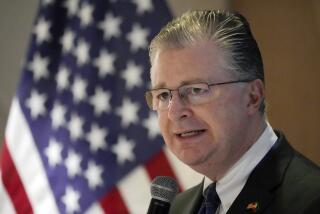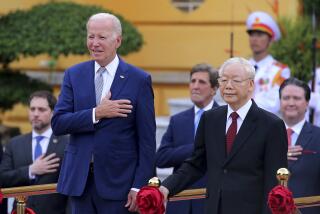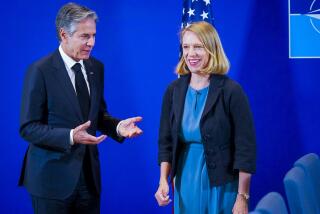Consulate Signals New Era With Vietnam
HO CHI MINH CITY, Vietnam — Secretary of State Madeleine Albright came to the abandoned American Embassy compound here Saturday and in a vacant lot laid the first brick for a new consulate, reestablishing after a 22-year absence the U.S. diplomatic presence in what was once Saigon.
The future consulate’s site stands in the shadow of the old fortress-like embassy, where U.S. Marines fought off Viet Cong attackers in the 1968 Tet offensive and from whose roof Ambassador Graham Martin and his staff fled in 1975 at the end of what Vietnamese people call the American War.
“To be able to look toward the future while standing in the shadow of the past makes this a very special occasion,” Albright later commented. She is the highest-ranking American official to visit this city since Martin lifted off from the embassy roof in a helicopter.
The old embassy, which will probably be razed, has been empty since the end of the war except when it was temporarily occupied by a state-run Vietnamese oil company. Barbed wire still stretches across the top of a high cement wall around the compound, and antennas that have not transmitted any messages in a generation still sprout from the roof.
In a brief ceremony attended by diplomats, Communist officials and Vietnamese businessmen, Albright, on her first trip to Vietnam, spoke of two peoples making a shared journey from the depths “of tragedy to the destination of deeper mutual respect.” She said both sides are working toward a trade agreement that could lead to the full normalization of relations between Washington and Hanoi.
Because of the 1 million Vietnamese Americans who live in the United States as a result of the war exodus, as well as because of growing U.S. business interest in Vietnam, the future consulate is expected to be extraordinarily busy. Albright said its staff of more than 100 Americans and Vietnamese will probably issue upward of 20,000 immigrant visas and 75,000 non-immigrant visas a year. They will also provide services to the 100,000 Americans who visit Vietnam annually.
Under terms of an agreement announced in Hanoi on Friday, Vietnam will also open a consulate in the United States, in San Francisco. The two sides also signed an agreement Friday protecting the copyrights of “intellectual property such as books, films and CDs.”
Beyond its importance for the 3,000 Americans who live in Ho Chi Minh City, Vietnam’s economic engine, the real significance of Albright’s visit was the promise that it could lead to improved conditions for foreign investment and business.
Albright told Prime Minister Vo Van Kiet that she is disappointed in the pace of Vietnam’s economic and social reform and believes Vietnam’s sometimes uncertain steps toward a free-market economy need to be re-energized. Western businesspeople eager to invest in the emerging economy of this nation of 75 million people appear to agree.
*
The Western euphoria that accompanied Vietnam’s move away from a state-run Communist economy and the lifting of the U.S. trade embargo in 1994 has clearly faded, and many businesspeople now say they were premature in thinking that Vietnam would suddenly join Thailand, Singapore, Malaysia and other economic “tigers” of Southeast Asia.
“I think what happened was that the enthusiasm of both sides [was] somewhat based on ignorance,” said American businessman Don De Vivo, whose group has invested $60 million in Vietnam. “There is a learning curve, and relationships like this take time.
“Vietnam really didn’t know what foreign investment was and what implications it held for the society and the government,” De Vivo continued. “And I think a lot of foreign investors saw Vietnam in terms of Thailand or Singapore. So many of the signals were the same.
“We’re just starting to understand how ignorant we were in the first place, and the Vietnamese are starting to understand that foreign investment isn’t just money coming in. Investors want to take out more than they put in. That is known as profit.”
Albright, accompanied by Douglas “Pete” Peterson, the new U.S. ambassador, who spent six years as a prisoner of war in North Vietnam, greeted a curious, friendly crowd of Vietnamese outside the old embassy after the bricklaying ceremony. She then stopped to tour the central market, which Viet Cong terrorists attacked regularly with grenades during the war to cause civilian casualties. Spying a beaded black purse she liked and having no local currency, she had to borrow 85,000 dong--about $7--from Peterson to make the purchase.
Before leaving for Hong Kong to attend ceremonies marking the end of British rule there, Albright and her advisors toured a hospital where a U.S. organization called Operation Smile surgically corrects children’s cleft palates. At the end of the long table at which she and Peterson were briefed, a bust of Ho Chi Minh stared down on them.
More to Read
Sign up for Essential California
The most important California stories and recommendations in your inbox every morning.
You may occasionally receive promotional content from the Los Angeles Times.










